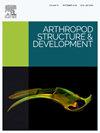Complete cycle of receptacle development in parasitic barnacle, Parasacculina pilosella (Van Kampen and Boschma, 1925) (Rhizocephala: Polyascidae)
IF 1.3
3区 农林科学
Q2 ENTOMOLOGY
引用次数: 0
Abstract
The complete cycle of receptacle development in the parasitic barnacle Parasacculina pilosella (Van Kampen and Boschma, 1925) (Rhizocephala: Polyascidae) was studied by light and electron microscopy. This rhizocephalan has two globular receptacles located outside the visceral sac. Two variants of development of the receptacles from the same externa were observed: (1) with both receptacles fertile and (2) with one of them (usually larger one) fertile and the other sterile. The presence of the second fertile receptacle probably extends the breeding season in P. pilosella. The following stages in the development of the fertile receptacle were identified: trichogon-free, trichogon-containing, early, middle, late, and degenerating. The sterile receptacle that has not received a trichogon, continued to develop and, after reaching the middle stage, atrophied. The cell types composing the receptacle wall (accessory, large female, polygonal, small-sized, and sheath cells) and the meshwork formed by the intercellular matrix were examined in detail. The accessory cells that separated spermatogenic and large female cells were probably derived from the trichogon which implanted cells of both germ and somatic lines. Globular and tubular receptacles had different fine organizations. Globular receptacles, as well as tubular ones, lacked morphological structures separating female and male organisms. Further studies, involving a larger number of other rhizocephalan species, are needed to clarify whether the receptacle ultrastructure can be useful in resolving taxonomic issues.
寄生藤壶,Parasacculina pilosella (Van Kampen and Boschma, 1925)中花托发育的完整循环(根头目:多囊科)
用光镜和电镜研究了寄生藤壶(rhizocephae: Polyascidae) (Parasacculina pilosella, Van Kampen and Boschma, 1925)的完整花筒发育周期。这根头茎有两个位于内脏囊外的球形花托。从同一外部观察到两种不同的花托发育:(1)两个花托都可育;(2)其中一个(通常较大)可育而另一个不育。第二个可育容器的存在可能延长了毛茛的繁殖季节。可育花托发育的阶段分为无毛蝗、含毛蝗、早期、中期、晚期和退化阶段。未接受毛状体的无菌容器,继续发育,到达中期后萎缩。详细观察了构成花托壁的细胞类型(副细胞、大雌细胞、多角形细胞、小细胞和鞘细胞)和细胞间基质形成的网状结构。分离生精细胞和大雌细胞的附属细胞可能来源于同时植入胚系和体细胞的毛滴虫。球状和管状花托有不同的细组织。球状花托和管状花托缺乏区分雌雄生物的形态结构。需要进一步的研究,包括更多的其他根头蕨物种,来澄清花托的超微结构是否可以用于解决分类问题。
本文章由计算机程序翻译,如有差异,请以英文原文为准。
求助全文
约1分钟内获得全文
求助全文
来源期刊
CiteScore
3.50
自引率
10.00%
发文量
54
审稿时长
60 days
期刊介绍:
Arthropod Structure & Development is a Journal of Arthropod Structural Biology, Development, and Functional Morphology; it considers manuscripts that deal with micro- and neuroanatomy, development, biomechanics, organogenesis in particular under comparative and evolutionary aspects but not merely taxonomic papers. The aim of the journal is to publish papers in the areas of functional and comparative anatomy and development, with an emphasis on the role of cellular organization in organ function. The journal will also publish papers on organogenisis, embryonic and postembryonic development, and organ or tissue regeneration and repair. Manuscripts dealing with comparative and evolutionary aspects of microanatomy and development are encouraged.

 求助内容:
求助内容: 应助结果提醒方式:
应助结果提醒方式:


